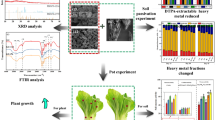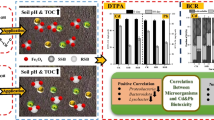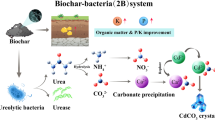Abstract
The combination of biochar and bacteria is a promising strategy for the remediation of Cd-polluted soils. However, the synergistic mechanisms of biochar and bacteria for Cd immobilization remain unclear. In this study, the experiments were conducted to evaluate the effects of the combination of biochar and Pseudomonas sp. AN-B15, on Cd immobilization, soil enzyme activity, and soil microbiome. The results showed that biochar could directly reduce the motility of Cd through adsorption and formation of CdCO3 precipitates, thereby protecting bacteria from Cd toxicity in the solution. In addition, bacterial growth further induces the formation of CdCO3 and CdS and enhances Cd adsorption by bacterial cells, resulting in a higher Cd removal rate. Thus, bacterial inoculation significantly enhances Cd removal in the presence of biochar in the solution. Moreover, soil incubation experiments showed that bacteria-loaded biochar significantly reduced soil exchangeable Cd in comparison with other treatments by impacting soil microbiome. In particular, bacteria-loaded biochar increased the relative abundance of Bacillus, Lysobacter, and Pontibacter, causing an increase in pH, urease, and arylsulfatase, thereby passivating soil exchangeable Cd and improving soil environmental quality in the natural alkaline Cd-contaminated soil. Overall, this study provides a systematic understanding of the synergistic mechanisms of biochar and bacteria for Cd immobilization in soil and new insights into the selection of functional strain for the efficient remediation of the contaminated environments by bacterial biochar composite.







Similar content being viewed by others
Data availability
The data underlying this article will be shared on reasonable request.
References
Bandick AK, Dick RP (1999) Field management effects on soil enzyme activities. Soil Biol Biochem 31:1471–1479. https://doi.org/10.1016/S0038-0717(99)00051-6
Bastian M, Heymann S, Jacomy M (2009) Gephi: an open source software for exploring and manipulating networks. Proc Int AAAI Conf Web Soc Media 3(1):361–362
Browman MG, Tabatabai MA (1978) Phosphodiesterase activity of soils. Soil Sci Soc Am J 42:284–290. https://doi.org/10.2136/sssaj1978.03615995004200020016x
Chang J, Yan Z, Dong J et al (2022) Mechanisms controlling the transformation of and resistance to mercury(II) for a plant-associated Pseudomonas sp. strain, AN-B15. J Hazard Mater 425:127948. https://doi.org/10.1016/j.jhazmat.2021.127948
Chen H, Tang L, Wang Z et al (2020) Evaluating the protection of bacteria from extreme Cd (II) stress by P-enriched biochar. Environ Pollut 263:114483. https://doi.org/10.1016/j.envpol.2020.114483
Chen Y, Chao Y, Li Y et al (2016) Survival strategies of the plant-associated bacterium Enterobacter sp. strain EG16 under cadmium stress. Appl Environ Microbiol 82:1734–1744. https://doi.org/10.1128/AEM.03689-15
Das S, Chou ML, Jean JS et al (2017) Arsenic-enrichment enhanced root exudates and altered rhizosphere microbial communities and activities in hyperaccumulator Pteris vittata. J Hazard Mater 325:279–287. https://doi.org/10.1016/j.jhazmat.2016.12.006
Das S, Jean JS, Kar S et al (2013) Effect of arsenic contamination on bacterial and fungal biomass and enzyme activities in tropical arsenic-contaminated soils. Biol Fertil Soils 49:757–765. https://doi.org/10.1007/s00374-012-0769-z
Dastager SG, Deepa CK, Pandey A (2011) Plant growth promoting potential of Pontibacter niistensis in cowpea (Vigna unguiculata (L.) Walp.). Appl Soil Ecol 49:250–255. https://doi.org/10.1016/j.apsoil.2011.04.016
Diao Y, Zhou L, Ji M et al (2022) Immobilization of Cd and Pb in soil facilitated by magnetic Biochar: metal speciation and microbial community evolution. Environ Sci Pollut Res 29:71871–71881. https://doi.org/10.1007/s11356-022-20750-9
Doelman P, Haanstra L (1986) Short- and long-term effects of heavy metals on urease activity in soils. Biol Fertil Soils 2:213–218. https://doi.org/10.1007/BF00260846
Eivazi F, Tabatabai MA (1988) Glucosidases and galactosidases in soils. Soil Biol Biochem 20:601–606. https://doi.org/10.1016/0038-0717(88)90141-1
Fan D, Han J, Chen Y et al (2018) Hormetic effects of Cd on alkaline phosphatase in soils across particle–size fractions in a typical coastal wetland. Sci Total Environ 613-614:792–797. https://doi.org/10.1016/j.scitotenv.2017.09.089
Guo Y, Li X, Liang L et al (2021) Immobilization of cadmium in contaminated soils using sulfidated nanoscale zero-valent iron: effectiveness and remediation mechanism. J Hazard Mater 420:126605. https://doi.org/10.1016/j.jhazmat.2021.126605
Han H, Wang X, Yao L et al (2020) Lettuce-derived rhizosphere polyamine-producing bacteria and their potential to reduce Cd and Pb accumulation in lettuce (Lactuca sativa L.). Environ Exp Bot 178:104161. https://doi.org/10.1016/j.envexpbot.2020.104161
Harindintwali JD, Zhou J, Yang W et al (2020) Biochar-bacteria-plant partnerships: eco-solutions for tackling heavy metal pollution. Ecotox Environ Safe 204:111020. https://doi.org/10.1016/j.ecoenv.2020.111020
Harvey OR, Herbert BE, Rhue RD et al (2011) Metal interactions at the biochar-water interface: energetics and structure-sorption relationships elucidated by flow adsorption microcalorimetry. Environ Sci Technol 45:5550–5556. https://doi.org/10.1021/es104401h
He L, Wang B, Cui H et al (2022) Clay-hydrochar composites return to cadmium contaminated paddy soil: reduced Cd accumulation in rice seed and affected soil microbiome. Sci Total Environ 835:155542. https://doi.org/10.1016/j.scitotenv.2022.155542
He L, Zhong H, Liu G et al (2019) Remediation of heavy metal contaminated soils by biochar: mechanisms, potential risks and applications in China. Environ Pollut 252:846–855. https://doi.org/10.1016/j.envpol.2019.05.151
Huang F, Li K, Wu RR et al (2020) Insight into the Cd2+ biosorption by viable Bacillus cereus RC-1 immobilized on different biochars: roles of bacterial cell and biochar matrix. J Clean Prod 272:122743. https://doi.org/10.1016/j.jclepro.2020.122743
Knights HE, Jorrin B, Haskett TL et al (2021) Deciphering bacterial mechanisms of root colonization. Environ Microbiol Rep 13:428–444. https://doi.org/10.1111/1758-2229.12934
Lee S, Han J, Ro HM (2022) Mechanistic insights into Cd(II) and As(V) sorption on miscanthus biochar at different pH values and pyrolysis temperatures. Chemosphere 287:132179. https://doi.org/10.1016/j.chemosphere.2021.132179
Li Q, Xing Y, Huang B et al (2022) Rhizospheric mechanisms of Bacillus subtilis bioaugmentation-assisted phytostabilization of cadmium-contaminated soil. Sci Total Environ 825:154136. https://doi.org/10.1016/j.scitotenv.2022.154136
Li X (2019) Technical solutions for the safe utilization of heavy metal-contaminated farmland in China: a critical review. Land Degrad Dev 30:1773–1784. https://doi.org/10.1002/ldr.3309
Liang L, Xi F, Tan W et al (2021) Review of organic and inorganic pollutants removal by biochar and biochar-based composites. Biochar 3:255–281. https://doi.org/10.1007/s42773-021-00101-6
Lu H, Zhang W, Yang Y et al (2012) Relative distribution of Pb2+ sorption mechanisms by sludge-derived biochar. Water Res 46:854–862. https://doi.org/10.1016/j.watres.2011.11.058
Lu R (1999) Analytical methods of soil agrochemistry. China Agricultural Science and Technology Publishing House, Beijing, China, pp 18–99
Lv H, Pian R, Xing Y et al (2020) Effects of citric acid on fermentation characteristics and bacterial diversity of Amomum villosum silage. Bioresour Technol 307:123290. https://doi.org/10.1016/j.biortech.2020.123290
Ma H, Wei M, Wang Z et al (2020) Bioremediation of cadmium polluted soil using a novel cadmium immobilizing plant growth promotion strain Bacillus sp. TZ5 loaded on Biochar. J Hazard Mater 388:122065. https://doi.org/10.1016/j.jhazmat.2020.122065
Manikandan SK, Nair V (2023) Dual-role of coconut shell biochar as a soil enhancer and catalyst support in bioremediation. Biomass Conv Bioref. https://doi.org/10.1007/s13399-023-04079-y
Mathivanan K, Chandirika JU, Mathimani T et al (2021) Production and functionality of exopolysaccharides in bacteria exposed to a toxic metal environment. Ecotox Environ Safe 208:111567. https://doi.org/10.1016/j.ecoenv.2020.111567
Medha I, Chandra S, Vanapalli KR et al (2021) (3-Aminopropyl)triethoxysilane and iron rice straw biochar composites for the sorption of Cr (VI) and Zn (II) using the extract of heavy metals contaminated soil. Sci Total Environ 771:144764. https://doi.org/10.1016/j.scitotenv.2020.144764
Mei C, Wang H, Cai K et al (2022) Characterization of soil microbial community activity and structure for reducing available Cd by rice straw Biochar and Bacillus cereus RC-1. Sci Total Environ 839:156202. https://doi.org/10.1016/j.scitotenv.2022.156202
Mohite BV, Koli SH, Patil SV (2018) Heavy metal stress and its consequences on exopolysaccharide (EPS)-producing Pantoea agglomerans. Appl Biochem Biotechnol 186:199–216. https://doi.org/10.1007/s12010-018-2727-1
Nannipieri P, Giagnoni L, Renella G et al (2012) Soil enzymology: classical and molecular approaches. Biol Fertil Soils 48:743–762. https://doi.org/10.1007/s00374-012-0723-0
Pan J, Yu L (2011) Effects of Cd or/and Pb on soil enzyme activities and microbial community structure. Ecol Eng 37:1889–1894. https://doi.org/10.1016/j.ecoleng.2011.07.002
Qi X, Gou J, Chen X et al (2021) Application of mixed bacteria-loaded biochar to enhance uranium and cadmium immobilization in a co-contaminated soil. J Hazard Mater 401:123823. https://doi.org/10.1016/j.jhazmat.2020.123823
Qi X, Xiao S, Chen X et al (2022) Biochar-based microbial agent reduces U and Cd accumulation in vegetables and improves rhizosphere microecology. J Hazard Mater 436:129147. https://doi.org/10.1016/j.jhazmat.2022.129147
Qian X, Lü Q, He X et al (2022) Pseudomonas sp. TCd-1 significantly alters the rhizosphere bacterial community of rice in Cd contaminated paddy field. Chemosphere 290:133257. https://doi.org/10.1016/j.chemosphere.2021.133257
Quilliam RS, Glanville HC, Wade SC et al (2013) Life in the ‘charosphere’ – does biochar in agricultural soil provide a significant habitat for microorganisms? Soil Biol Biochem 65:287–293. https://doi.org/10.1016/j.soilbio.2013.06.004
Rahman Z (2020) An overview on heavy metal resistant microorganisms for simultaneous treatment of multiple chemical pollutants at co-contaminated sites, and their multipurpose application. J Hazard Mater 396:122682. https://doi.org/10.1016/j.jhazmat.2020.122682
Rahman Z, Singh VP (2019) The relative impact of toxic heavy metals (THMs) (arsenic (As), cadmium (Cd), chromium (Cr)(VI), mercury (Hg), and lead (Pb)) on the total environment: an overview. Environ Monit Assess 191:419. https://doi.org/10.1007/s10661-019-7528-7
Rathnayake D, Rego F, Van Poucke R et al (2021) Chemical stabilization of Cd-contaminated soil using fresh and aged wheat straw biochar. Environ Sci Pollut Res 28:10155–10166. https://doi.org/10.1007/s11356-020-11574-6
Rees F, Simonnot MO, Morel JL (2014) Short-term effects of biochar on soil heavy metal mobility are controlled by intra-particle diffusion and soil pH increase. Eur J Soil Sci 65:149–161. https://doi.org/10.1111/ejss.12107
Ren X, He J, Chen Q et al (2022) Marked changes in biochar’s ability to directly immobilize Cd in soil with aging: implication for biochar remediation of Cd-contaminated soil. Environ Sci Pollut Res 29:73856–73864. https://doi.org/10.1007/s11356-022-21000-8
Stressler T, Seitl I, Kuhn A et al (2016) Detection, production, and application of microbial arylsulfatases. Appl Microbiol Biotechnol 100:9053–9067. https://doi.org/10.1007/s00253-016-7838-4
Tabatabai MA, Bremner JM (1970) Arylsulfatase activity of soils. Soil Sci Soc Am J 34:225–229. https://doi.org/10.2136/sssaj1970.03615995003400020016x
Tan WT, Zhou H, Tang SF et al (2022) Enhancing Cd(II) adsorption on rice straw biochar by modification of iron and manganese oxides. Environ Pollut 300:118899. https://doi.org/10.1016/j.envpol.2022.118899
Tang J, Zhang L, Zhang J et al (2020) Physicochemical features, metal availability and enzyme activity in heavy metal-polluted soil remediated by biochar and compost. Sci Total Environ 701:134751. https://doi.org/10.1016/j.scitotenv.2019.134751
Tessier A, Campbell PGC, Bisson M (1979) Sequential extraction procedure for the speciation of particulate trace metals. Anal Chem 51:844–851. https://doi.org/10.1021/ac50043a017
Tu C, Wei J, Guan F, Liu Y et al (2020) Biochar and bacteria inoculated Biochar enhanced Cd and Cu immobilization and enzymatic activity in a polluted soil. Environ Int 137:105576. https://doi.org/10.1016/j.envint.2020.105576
Wang X, Hu K, Xu Q et al (2020a) Immobilization of Cd using mixed Enterobacter and Comamonas bacterial reagents in pot experiments with Brassica rapa L. Environ Sci Technol 54:15731–15741. https://doi.org/10.1021/acs.est.0c03114
Wang Y, Liu Y, Zhan W et al (2020b) Stabilization of heavy metal-contaminated soils by biochar: challenges and recommendations. Sci Total Environ 729:139060. https://doi.org/10.1016/j.scitotenv.2020.139060
Wasi S, Tabrez S, Ahmad M (2013) Use of Pseudomonas spp. for the bioremediation of environmental pollutants: a review. Environ Monit Assess 185:8147–8155. https://doi.org/10.1007/s10661-013-3163-x
Xia X, Wu S, Zhou Z et al (2021) Microbial Cd(II) and Cr(VI) resistance mechanisms and application in bioremediation. J Hazard Mater 401:123685. https://doi.org/10.1016/j.jhazmat.2020.123685
Xu Q, Xu Q, Zhu H et al (2022) Does biochar application in heavy metal-contaminated soils affect soil micronutrient dynamics? Chemosphere 290:133349. https://doi.org/10.1016/j.chemosphere.2021.133349
Yang Q, Cui P, Liu C et al (2021a) In situ stabilization of the adsorbed Co2+ and Ni2+ in rice straw biochar based on LDH and its reutilization in the activation of peroxymonosulfate. J Hazard Mater 416:126215. https://doi.org/10.1016/j.jhazmat.2021.126215
Yang T, Meng J, Jeyakumar P et al (2021b) Effect of pyrolysis temperature on the bioavailability of heavy metals in rice straw-derived biochar. Environ Sci Pollut Res 28:2198–2208. https://doi.org/10.1007/s11356-020-10193-5
Yu Q, Mishra B, Fein JB (2020) Role of bacterial cell surface sulfhydryl sites in cadmium detoxification by Pseudomonas putida. J Hazard Mater 391:122209. https://doi.org/10.1016/j.jhazmat.2020.122209
Yu X, Zhao J, Liu X et al (2021) Cadmium pollution impact on the bacterial community structure of arable soil and the isolation of the cadmium resistant bacteria. Front Microbiol 12:698834. https://doi.org/10.3389/fmicb.2021.698834
Yuan X, Xue N, Han Z (2021) A meta-analysis of heavy metals pollution in farmland and urban soils in China over the past 20 years. J Environ Sci 101:217–226. https://doi.org/10.1016/j.jes.2020.08.013
Yuan Z, Yi H, Wang T et al (2017) Application of phosphate solubilizing bacteria in immobilization of Pb and Cd in soil. Environ Sci Pollut Res 24:21877–21884. https://doi.org/10.1007/s11356-017-9832-5
Zeng S, Ma J, Yang Y et al (2019) Spatial assessment of farmland soil pollution and its potential human health risks in China. Sci Total Environ 687:642–653. https://doi.org/10.1016/j.scitotenv.2019.05.291
Zhang F, Wang X, Yin D et al (2015) Efficiency and mechanisms of Cd removal from aqueous solution by biochar derived from water hyacinth (Eichornia crassipes). J Environ Manage 153:68–73. https://doi.org/10.1016/j.jenvman.2015.01.043
Zhang L, Guan Y (2022) Microbial investigations of new hydrogel-biochar composites as soil amendments for simultaneous nitrogen-use improvement and heavy metal immobilization. J Hazard Mater 424:127154. https://doi.org/10.1016/j.jhazmat.2021.127154
Zhao FJ, Ma Y, Zhu YG et al (2015) Soil contamination in China: current status and mitigation strategies. Environ Sci Technol 49:750–759. https://doi.org/10.1021/es5047099
Zhao J, Ma J, Yang Y et al (2021) Response of soil microbial community to vegetation reconstruction modes in mining areas of the loess plateau, China. Front Microbiol 12. https://doi.org/10.3389/fmicb.2021.714967
Zheng X, Xu W, Dong J et al (2022) The effects of biochar and its applications in the microbial remediation of contaminated soil: a review. J Hazard Mater 438:129557. https://doi.org/10.1016/j.jhazmat.2022.129557
Zheng Y, Xiao C, Chi R (2021) Remediation of soil cadmium pollution by biomineralization using microbial-induced precipitation: a review. World J Microbiol Biotechnol 37:208. https://doi.org/10.1007/s11274-021-03176-2
Zhu Y, Liu H, Qiao C et al (2017) Characterization of an arylsulfatase from a mutant library of Pseudoalteromonas carrageenovora arylsulfatase. Int J Biol Macromol 96:370–376. https://doi.org/10.1016/j.ijbiomac.2016.12.014
Zhu Y, Lv X, Song J et al (2022a) Application of cotton straw biochar and compound Bacillus biofertilizer decrease the bioavailability of soil cd through impacting soil bacteria. BMC Microbiol 22:35. https://doi.org/10.1186/s12866-022-02445-w
Zhu Y, Wang L, You Y et al (2022b) Enhancing network complexity and function of soil bacteria by thiourea-modified biochar under cadmium stress in post-mining area. Chemosphere 302:134811. https://doi.org/10.1016/j.chemosphere.2022.134811
Funding
This work was supported by the Department of Science and Technology of Yunnan Province (202201BF070001-002, 202201AS070016) and National Natural Science Foundation of China (32260315, 4216070223).
Author information
Authors and Affiliations
Contributions
Jinquan Chen and Chang’e Liu have made substantial contributions to the conception or design of the work and analysis or interpretation of data for the work. Jinquan Chen has drafted the work or revised it critically for important intellectual content. Zhengjian Yan, Zitong Wang, Guangzhng Si, Guohui Chen, and Tingting Feng performed all the experiments. All persons who have made substantial contributions to the work were reported in the manuscript.
Corresponding author
Ethics declarations
Ethics approval and consent to participate
Not applicable.
Consent for publication
Agree.
Consent for participate
Agree.
Competing interests
The authors declare no competing interests.
Additional information
Responsible Editor: Kitae Baek
Publisher’s Note
Springer Nature remains neutral with regard to jurisdictional claims in published maps and institutional affiliations.
Zhengjian Yan and Zitong Wang are co-first authors.
Supplementary information
ESM 1
(DOCX 176 kb)
Rights and permissions
Springer Nature or its licensor (e.g. a society or other partner) holds exclusive rights to this article under a publishing agreement with the author(s) or other rightsholder(s); author self-archiving of the accepted manuscript version of this article is solely governed by the terms of such publishing agreement and applicable law.
About this article
Cite this article
Yan, ., Wang, Z., Si, G. et al. Bacteria-loaded biochar for the immobilization of cadmium in an alkaline-polluted soil. Environ Sci Pollut Res 31, 1941–1953 (2024). https://doi.org/10.1007/s11356-023-31299-6
Received:
Accepted:
Published:
Issue Date:
DOI: https://doi.org/10.1007/s11356-023-31299-6




